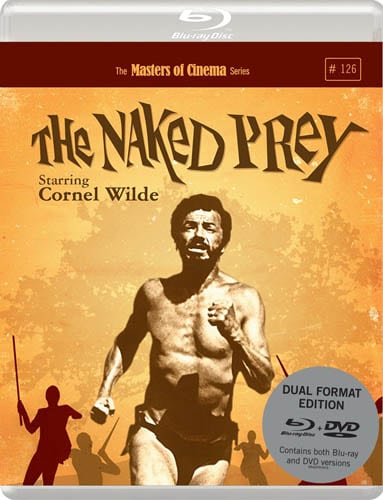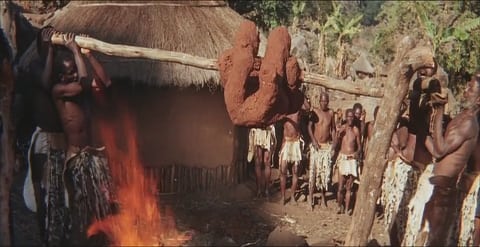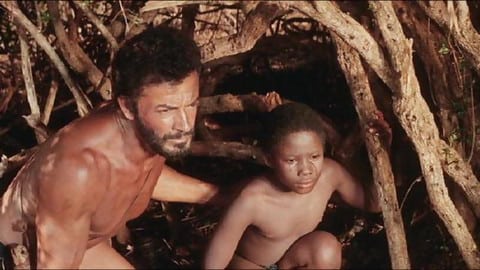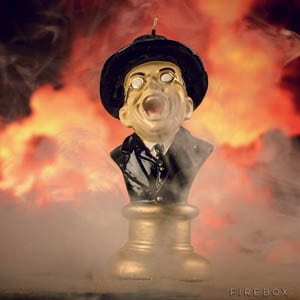The Naked Prey (1965)
Directed by: Cornel Wilde
Written by: Clint Johnston, Don Peters
Starring: Cornel Wilde, Gert van den Bergh, Ken Gampu, Patrick Mynhardt
USA
AVAILABLE ON DUAL FORMAT BLU-RAY AND DVD: 19th October, from EUREKA ENTERTAINMENT
RUNNING TIME: 96 min
REVIEWED BY: Dr Lenera, Official HCF Critic
A professional safari guide [unnamed] is leading two white men and their troupe on an elephant hunt through the African veldt during the colonial era. When the group intrudes on a local tribe’s territory, some natives politely accost them, expecting to be bought off with gifts. Although the guide advises his client to be courteous, warning “they could give us a bad time”, the client refuses to offer anything and insults the natives, sending them away empty-handed. Later, the tribe returns en masse, captures the entire party, and puts the captives to death except for the safari guide, who is stripped naked and forced to run for his life with some of the tribesmen close behind….
Back in the days of video, I almost picked up and bought The Naked Prey [which if I remember correctly actually had a ‘PG’ certificate!] several times in my local Smiths, but being not really very different from the way I am now, I always ended up buying something else. In time I learnt that the film had a considerable reputation and, much like the horror film The Skull which I reviewed last week, and also from a new Blu-ray released by Eureka Entertainment [maybe the honchos at the company have access to my mind], I never ended up seeing or buying the thing until now. And what a film it is, a gripping, uncompromising and stunningly photographed outdoor ‘boy’s own’ adventure which uses the minimum of dialogue and actually feels quite modern except for the fact that PC types would probably label it as racist, which it most definitely isn’t, and even anti-environmentalist, in the process missing the point that this film is not about good versus evil but survival and respect. I suppose, if I wanted to pigeon-hole it, I’d call it a cross between Walkabout and Apocalypto, though of course neither of those other two films had been made yet. As I watched The Naked Prey, it seemed to me that Mel Gibson’s film took quite a lot from it, as did, come to think of it, Jeremiah Johnson, but all this in a way takes away from The Naked Prey which, at least for its day, was quite unique and is still extremely interesting.
Star and director Cornel Wilde had a rather interesting career, a matinee idol who developed into a director who made eleven quite individualistic pictures, usually starring himself, which he had some control over. The one I’m most familiar with is the underrated war movie Beach Red which I thoroughly recommend. Anyway, The Naked Prey was inspired by the true story of fur trapper John Colter who, in 1808, was attacked by Blackfoot Native Americans in Montana. They killed his companion and, after stripping him naked, gave him a 30-second head start to run for his life, initiating a chase that went into Wyoming. Wilde originally wanted to film this story accurately, but lower shooting costs [for what was basically an independent production], tax breaks, plus material and logistical assistance offered by South Africa eventually convinced him and the other producers to shoot the film there, giving scriptwriters Clint Johnson and Don Peters to change many details. The Naked Prey was shot mostly in Zimbabwe, and throughout what was a gruelling shoot the 52-year old Wilde, despite being in excellent condition for his age, was sick for much of the time, but pressed on, saying the illness added to his performance. He was also bitten by a lizard and had to taken to hospital when he tried to save it from a python while filming one of the animal scenes, and was even almost killed when a spear narrowly missed him, a shot that was kept in. The Naked Prey was released to decent reviews and box office.
The film doesn’t specify exactly which country or countries it takes place in, though it does open with a bit of scene-setting narration which seems unnecessary and, though I’m probably wrong here, smacks a bit of studio intervention. Nor does it gave any of its characters names in the credits, though Wilde’s character’s client calls him Larry a couple of times so I’m going to call him that from now on. Right from the beginning we’re given lots of animal stock footage which is cut into the main action, and for some modern eyes this is maybe a little jarring, though I thought it worked quite well considering I’m familiar with most the old Tarzan movies where stock shots would be repeated over and over again and often not look they were a part of the film at all! There’s a scene early on which really leaves a bad taste in the mouth where Larry and his client shoot lots of elephants which animal lovers should really be warned about. Now of course the shots of elephants being killed is footage from elsewhere, except for possibly the aftermath where they eat one of them [I’m not sure, but it sure looked convincing!] but the film isn’t exactly going out of its way to make Larry a sympathetic character, even if he doesn’t like it when his client shoots a few extra elephants just for sport. I don’t think in any way the film is saying elephant hunting is a good thing, and, while it’s Larry’s client, who really does seem like a bit of a racist, who causes the group to be suddenly attacked by loads of spear wielding tribesmen, for me it was the sight of those lovely animals falling to their deaths that actually made me almost want to cheer when the members of the expedition start to be put to death, one by one.
At this stage the film really doesn’t seem far from one of those later Italian cannibal movies, what with one guy encased in clay and roasted over a fire, and another being tarred, feathered, and trussed, then chased and killed by all the women. While the film [remember it was made in 1965] avoids showing the nastiest details, it’s still quite harrowing and pretty strong stuff for the time. Larry is spared until the last. He is stripped naked and forced to fetch an arrow that was shot by one of the tribesmen. Instead of fetching the arrow, he runs by it, resulting in him being chased by some of the tribesmen. The rest of the film is basically an extended chase. No, there’s not a lot of plot – how could there be when the script only ran to just nine pages long – but The Naked Prey is pretty gripping as Larry has to survive, even being reduced to eating a snail, while eluding and sometimes battling his pursuers. Sometimes the headlong pace of the stripped-to-the-bones scenario does slow down just a little to give us a breather, most notably when he befriends a little girl and we get a really sweet scene [though even here the movie avoids being sentimental] when he sings a nineteenth-century drinking song, Little Brown Jug, and the child sings a song in her own language; they then attempt to sing each other’s songs.
How anyone can claim The Naked Prey is racist after seeing the scene above, or remembering that it was one white man’s arrogance [who says he wants to be a slave trader!] who started the whole thing, is beyond me, but some people sadly do. The film is even brave enough [in the way a modern film probably wouldn’t – I feel that things have really gone too far the other way now] to remind us some uncomfortable truths. Yes, the tribe who attacks the village of another [in another vividly nasty set piece] may be working for white slave traders, but it reminds us that slavery still continues to exist amongst many African tribes. The film doesn’t shy away from what many of us would consider barbarism, yet is balanced enough to grant Larry’s pursuers moments of humanity – when one dies and his death is mourned, the viewer feels the sadness – and, while they still belong to a tribe who may to us seem like savages, that tribe still has its own code. In the end I don’t think Larry [who even starts a forest fire in one scene – you wouldn’t have the hero of a modern film do that] is necessarily intended to be substantially nicer than anyone else in the film, but he does show respect to others. The film finishes with a look being exchanged, and actually it’s more interesting if you think about the point of view of the black man rather than the white man. Not only has he come to respect his quarry, but he also finally gets the respect from his tribesmen he wasn’t given at the start of the picture. This the kind of great movie moment I often love above all else – no words, no stretching anything out, no over-the-top emotion – just a look which, as we all know, can say more than anything else.
The final chase is a little brief for what is basically the climax, and you could say that, despite it being based on fact, it’s still a bit unrealistic than Wilde’s character can out-run warriors half his age and survive out there for more than five minutes, but the sheer toughness which Wilde projects makes one forget that for some of the time. In a way, it’s Ken Gampu who has the tougher role in terms of acting, because his character has to change a bit and show more emotion, something Gampu does expertly. H.A.R.’s cinematography of Africa, which I feel evokes its settings as well as Out Of Africa, is absolutely superb and truly makes the most of both the beauty and the harshness of the locations, while, instead of a conventional music score, we get African drumming and chanting which really helps give an authenticity to the proceedings. This deceptively simple, harsh and extremely exciting movie is a minor adventure classic and seems, to me, to say a message which might be unpalatable to some but to me is very realistic and sensible. We don’t have to like other cultures – in fact it could be in our nature not to – but we should at least be respectful of them.
Eureka Entertainment’s Blu-ray of The Naked Prey looks absolutely stunning in every way – you’d think the film was made yesterday – and I can’t really fault it all. Colour, depth, detail – it’s all outstanding and probably better than the film looked in 1965 cinemas. It has different special features than the Region ‘A’ Criterion release [which included a commentary], and slightly less, but the video interview tells you all you probably want to know about the film.
SPECIAL FEATURES:
*New video interview with film historian Sheldon Hall (30:54)
*Trailer (3:13)
*Booklet containing a 1970 interview with Cornel Wilde, and the original 1903 basis for the film John Colter’s Escape









Be the first to comment